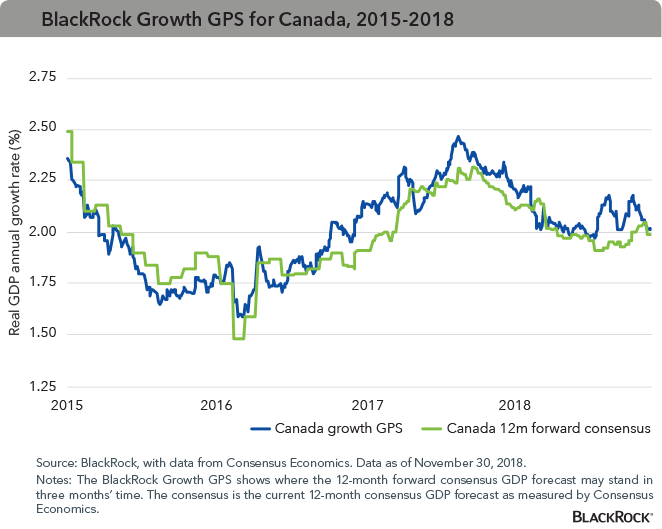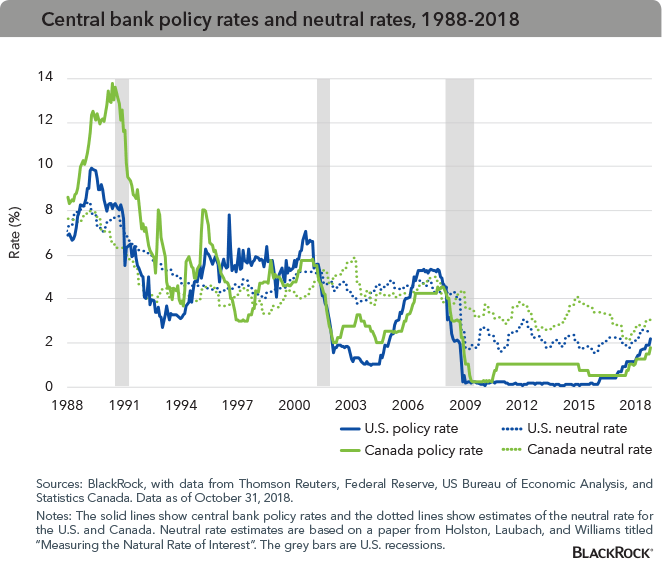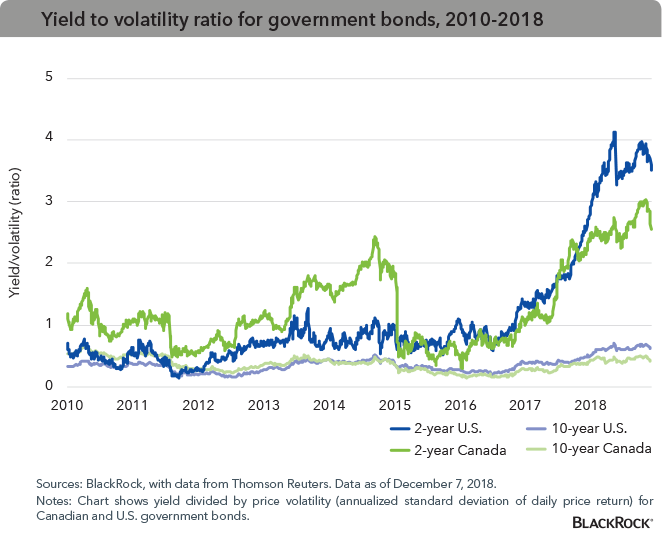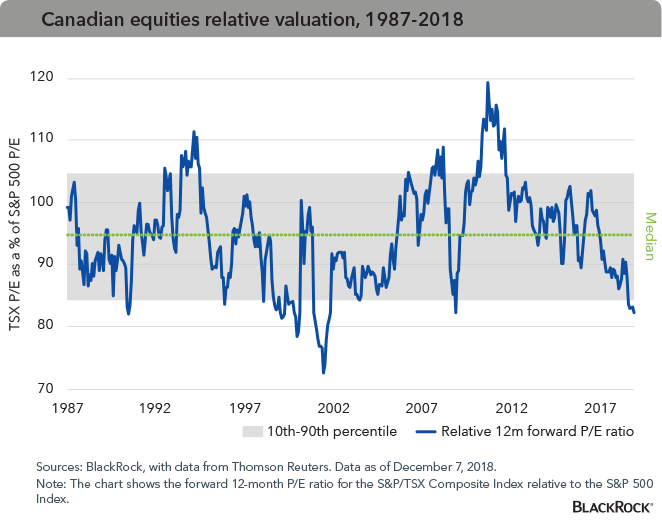Kurt and Aubrey share their 2019 outlook for the Canadian economy and financial markets, highlighting three key themes: growth slowdown, nearing neutral, and balancing risk and reward.
Slowing global economic activity and the potential for building recession fears will likely weigh on the prospects for the Canadian economy and financial markets in the year ahead. Fortunately, a lot of bad news is already priced into Canadian risk assets after a second consecutive year of underperformance versus global equity markets.
Our estimate for Canada points to the economy expanding at a roughly 2.0% pace during 2019, roughly consistent with current consensus estimates and the Bank of Canada’s (BoC) own forecasts (see chart below). That said, economic activity in Canada appears to be slowing, in line with the growth slowdown theme. Investment uncertainty related to North American Free Trade Agreement (NAFTA) renegotiations may have eased given the likely legislative approval of the reworked trade deal in 2019. Yet low domestic oil prices, lagged effects of tighter financial conditions on high household indebtedness, fading U.S. fiscal stimulus and heightened U.S./China tensions will likely hold back economic activity in Canada in the coming quarters.
The economic picture isn’t entirely bleak. Federal and provincial efforts to reverse deep price differentials for Canadian crude have recently begun to take effect and may soon gain traction. Newly introduced federal tax incentives on new business investment may give a boost to corporate spending plans as NAFTA and oil price uncertainties fade. Vibrant activity in artificial intelligence, machine learning and green tech are leading to new sources of growth in the Canadian economy at a time when traditional manufacturing and natural resources demand are slipping. And we see little imminent risk of a U.S. recession, although we see the probabilities becoming more material in 2020 and beyond.
These conditions point to a much more gradual pace of rate hikes by the BoC in 2019 than we saw in 2018 though intensification of late cycle risks could well bring the tightening cycle to a halt. This dovetails with our outlook for the Federal Reserve and our nearing neutral theme (see chart below). Inflation is well contained despite historically low unemployment, capacity constraints across multiple sectors of the Canadian economy, and further narrowing of output gaps. While central bank officials would prefer to see the overnight lending rate rise (to have ammunition in the event of a downturn), they are likely eager to pause to see the effects of past efforts on rate-sensitive sectors of the economy.
Our third theme – balancing risk and reward– focuses on building resilience in portfolios. We prefer the front end of the Canadian fixed income market to achieve a couple of goals in 2019: a higher yield than cash and lower interest rate risk than longer-maturity bonds, without giving up much yield (see chart below). For some investors, reducing spread exposure and adding duration risk could provide better ballast for the portfolio during a period of elevated uncertainty and financial market volatility. For those who are able to tolerate greater risk and volatility, we also prefer exposures to hard currency emerging market debt given the attractive yield advantage and improved external funding status of many countries.
We also maintain an emphasis on emerging market stocks, as well as a preference for the U.S. and quality exposures. U.S. and emerging market earnings estimates appear fair and are typically less susceptible to downgrades throughout the year than European and Canadian equity markets (see chart below). Looking through a sector lens, we have upgraded our view on global health care, while also maintaining our bias toward global technology. Both sectors are substantially underrepresented in the Canadian equity market, which means Canadian investors will again need to venture to international markets to gain exposure.
We prefer unhedged exposures to international stocks for Canadian investors, since the Canadian dollar tends to be procyclical. Weakness in the loonie on any global equity selloff would tend to limit losses in foreign markets. We also see limited room for appreciation in the loonie given the troubles in the oil patch, a skeptical foreign investor community and a rather dovish stance from the BoC, as discussed above.
We recognize the value advantage of Canadian stocks, especially versus U.S. equities. Canadian stocks have rarely been this cheap over the past 30 years – based on both forward price-to-earnings and price-to-book ratios – and have typically outperformed over the subsequent year when they reach these levels (see chart below). Yet there are many questions hanging over the Canadian economy that could prompt downward earnings revisions over the course of the year, as we’ve consistently seen in the past. Without a material rebound in oil prices and without more exposure to the sectors we prefer, Canadian stocks may find it difficult to outperform in 2019.
Kurt Reiman is a Managing Director and BlackRock’s Chief Investment Strategist for Canada. Kurt is a regular contributor to The Blog in Canada.
Aubrey Basdeo is a Managing Director and Head of Canadian Fixed Income for BlackRock. Aubrey is a regular contributor to The Blog in Canada.


















